engine TOYOTA YARIS HATCHBACK 2020 Warranties & Maintenance Guides (in English)
[x] Cancel search | Manufacturer: TOYOTA, Model Year: 2020, Model line: YARIS HATCHBACK, Model: TOYOTA YARIS HATCHBACK 2020Pages: 58, PDF Size: 0.92 MB
Page 8 of 58
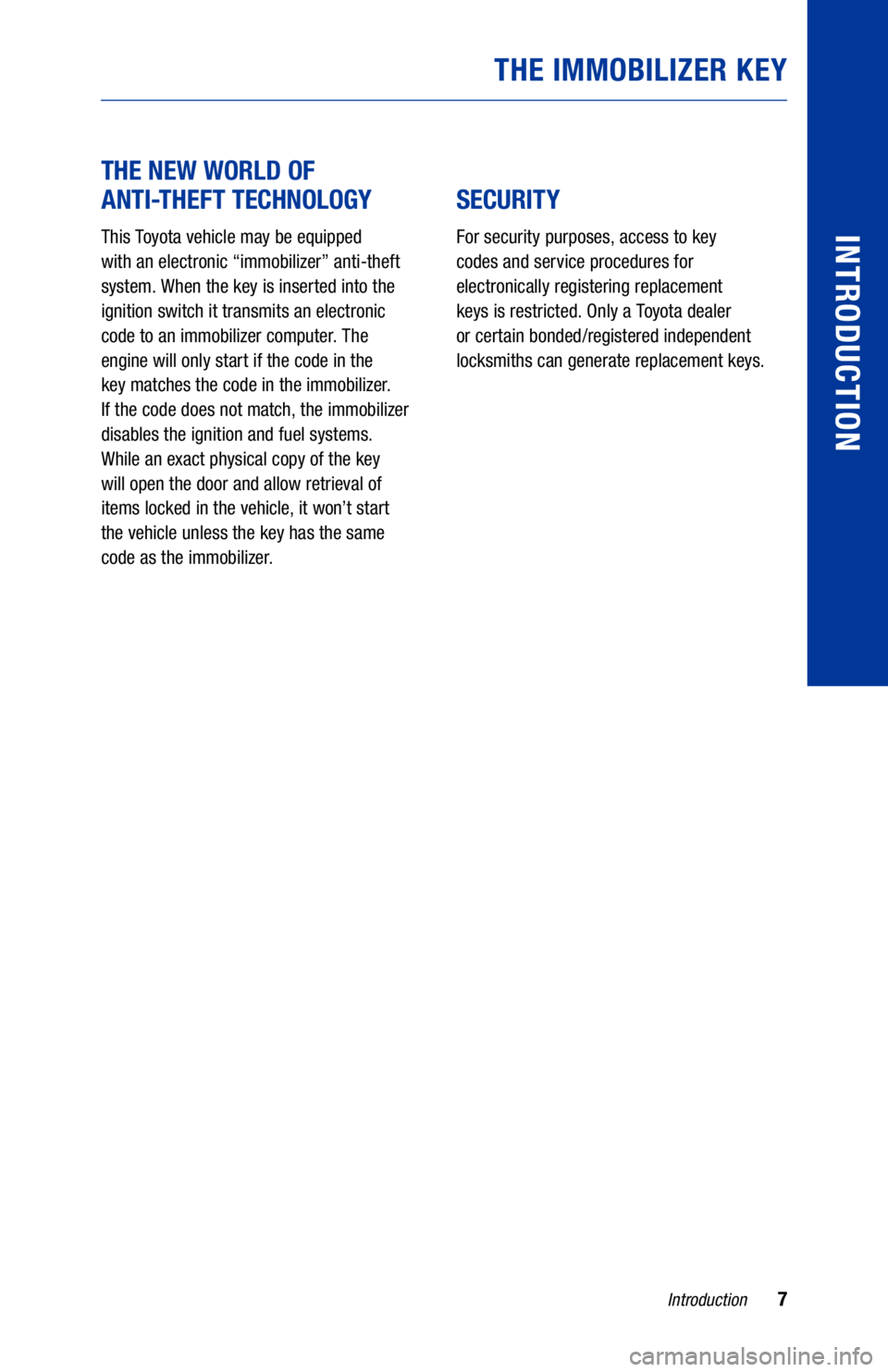
7
THE NEW WORLD OF
ANTI-THEFT TECHNOLOGY
This Toyota vehicle may be equipped
with an electronic “immobilizer” anti-theft
system. When the key is inserted into the
ignition switch it transmits an electronic
code to an immobilizer computer. The
engine will only start if the code in the
key matches the code in the immobilizer.
If the code does not match, the immobilizer
disables the ignition and fuel systems.
While an exact physical copy of the key
will open the door and allow retrieval of
items locked in the vehicle, it won’t start
the vehicle unless the key has the same
code as the immobilizer.
SECURITY
For security purposes, access to key
codes and service procedures for
electronically registering replacement
keys is restricted. Only a Toyota dealer
or certain bonded/registered independent
locksmiths can generate replacement keys.
THE IMMOBILIZER KEY
Introduction
INTRODUCTION
Page 9 of 58
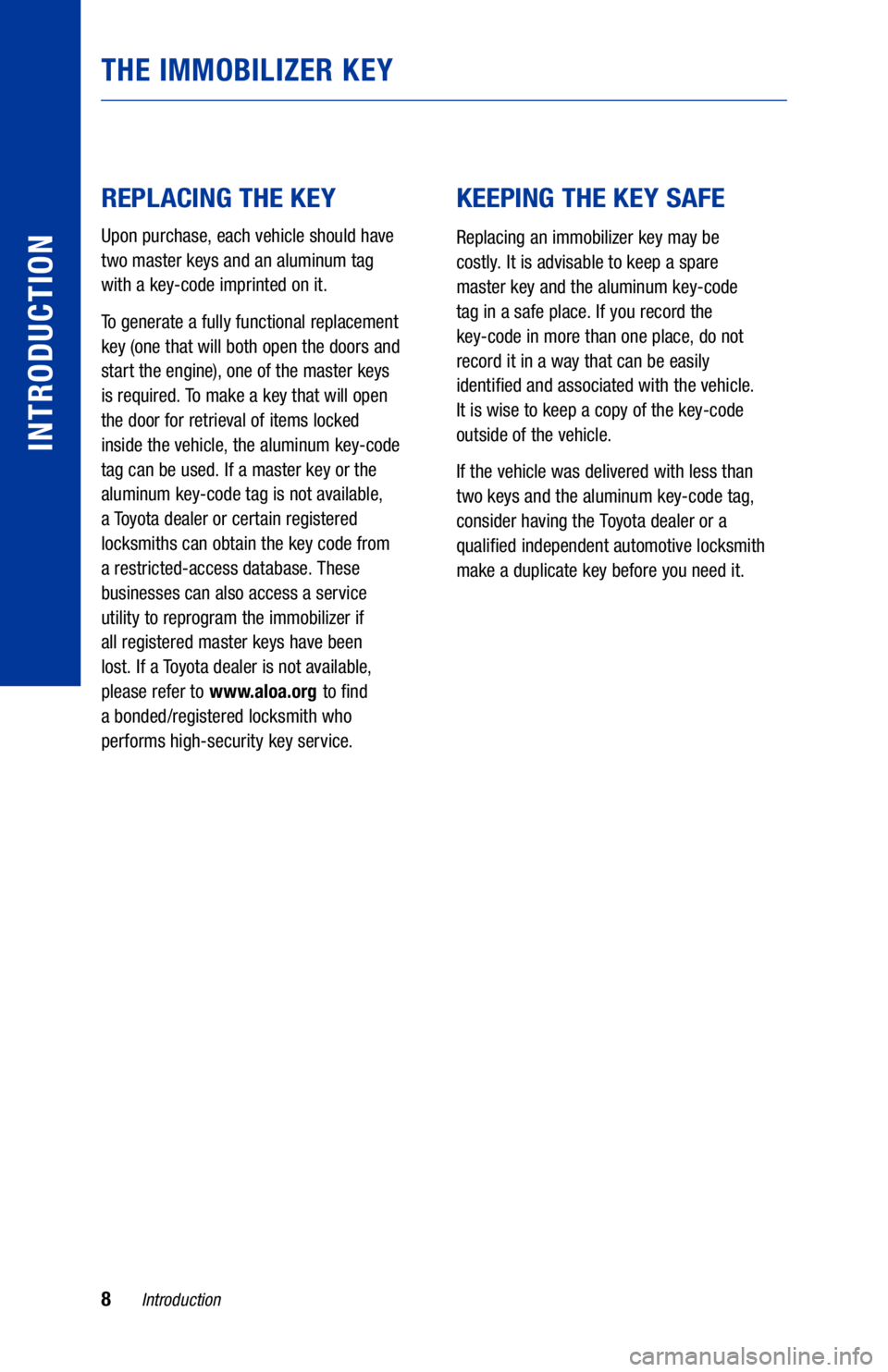
REPLACING THE KEY
Upon purchase, each vehicle should have
two master keys and an aluminum tag
with a key-code imprinted on it.
To generate a fully functional replacement
key (one that will both open the doors and
start the engine), one of the master keys
is required. To make a key that will open
the door for retrieval of items locked
inside the vehicle, the aluminum key-code
tag can be used. If a master key or the
aluminum key-code tag is not available,
a Toyota dealer or certain registered
locksmiths can obtain the key code from
a restricted-access database. These
businesses can also access a service
utility to reprogram the immobilizer if
all registered master keys have been
lost. If a Toyota dealer is not available,
please refer to www.aloa.org to find
a bonded/registered locksmith who
performs high-security key service.
KEEPING THE KEY SAFE
Replacing an immobilizer key may be
costly. It is advisable to keep a spare
master key and the aluminum key-code
tag in a safe place. If you record the
key-code in more than one place, do not
record it in a way that can be easily
identified and associated with the vehicle.
It is wise to keep a copy of the key-code
outside of the vehicle.
If the vehicle was delivered with less than
two keys and the aluminum key-code tag,
consider having the Toyota dealer or a
qualified independent automotive locksmith
make a duplicate key before you need it.
8
THE IMMOBILIZER KEY
Introduction
INTRODUCTION
Page 14 of 58
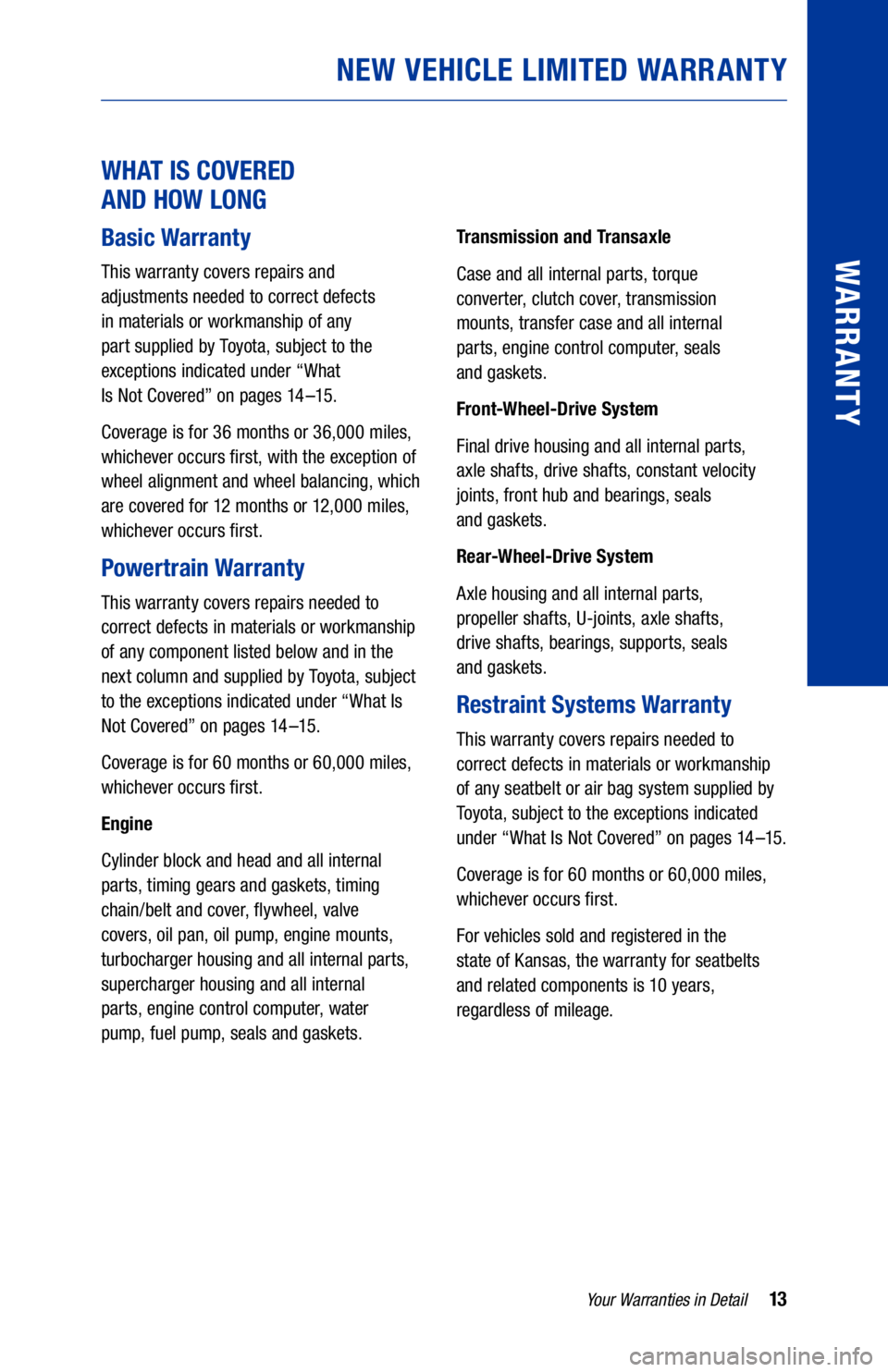
WHAT IS COVERED
AND HOW LONG
Basic Warranty
This warranty covers repairs and
adjustments needed to correct defects
in materials or workmanship of any
part supplied by Toyota, subject to the
exceptions indicated under “What
Is Not Covered” on pages 14 –15.
Coverage is for 36 months or 36,000 miles,
whichever occurs first, with the exception of
wheel alignment and wheel balancing, which
are covered for 12 months or 12,000 miles,
whichever occurs first.
Powertrain Warranty
This warranty covers repairs needed to
correct defects in materials or workmanship
of any component listed below and in the
next column and supplied by Toyota, subject
to the exceptions indicated under “What Is
Not Covered” on pages 14 –15.
Coverage is for 60 months or 60,000 miles,
whichever occurs first.
Engine
Cylinder block and head and all internal
parts, timing gears and gaskets, timing
chain/belt and cover, flywheel, valve
covers, oil pan, oil pump, engine mounts,
turbocharger housing and all internal parts,
supercharger housing and all internal
parts, engine control computer, water
pump, fuel pump, seals and gaskets.
Transmission and Transaxle
Case and all internal parts, torque
converter, clutch cover, transmission
mounts, transfer case and all internal
parts, engine control computer, seals
and gaskets.
Front-Wheel-Drive System
Final drive housing and all internal parts,
axle shafts, drive shafts, constant velocity
joints, front hub and bearings, seals
and gaskets.
Rear-Wheel-Drive System
A xle housing and all internal parts,
propeller shafts, U-joints, axle shafts,
drive shafts, bearings, supports, seals
and gaskets.
Restraint Systems Warranty
This warranty covers repairs needed to
correct defects in materials or workmanship
of any seatbelt or air bag system supplied by
Toyota, subject to the exceptions indicated
under “What Is Not Covered” on pages 14 –15.
Coverage is for 60 months or 60,000 miles,
whichever occurs first.
For vehicles sold and registered in the
state of Kansas, the warranty for seatbelts
and related components is 10 years,
regardless of mileage.
13
NEW VEHICLE LIMITED WARRANTY
Your Warranties in Detail
WARRANTY
Page 16 of 58
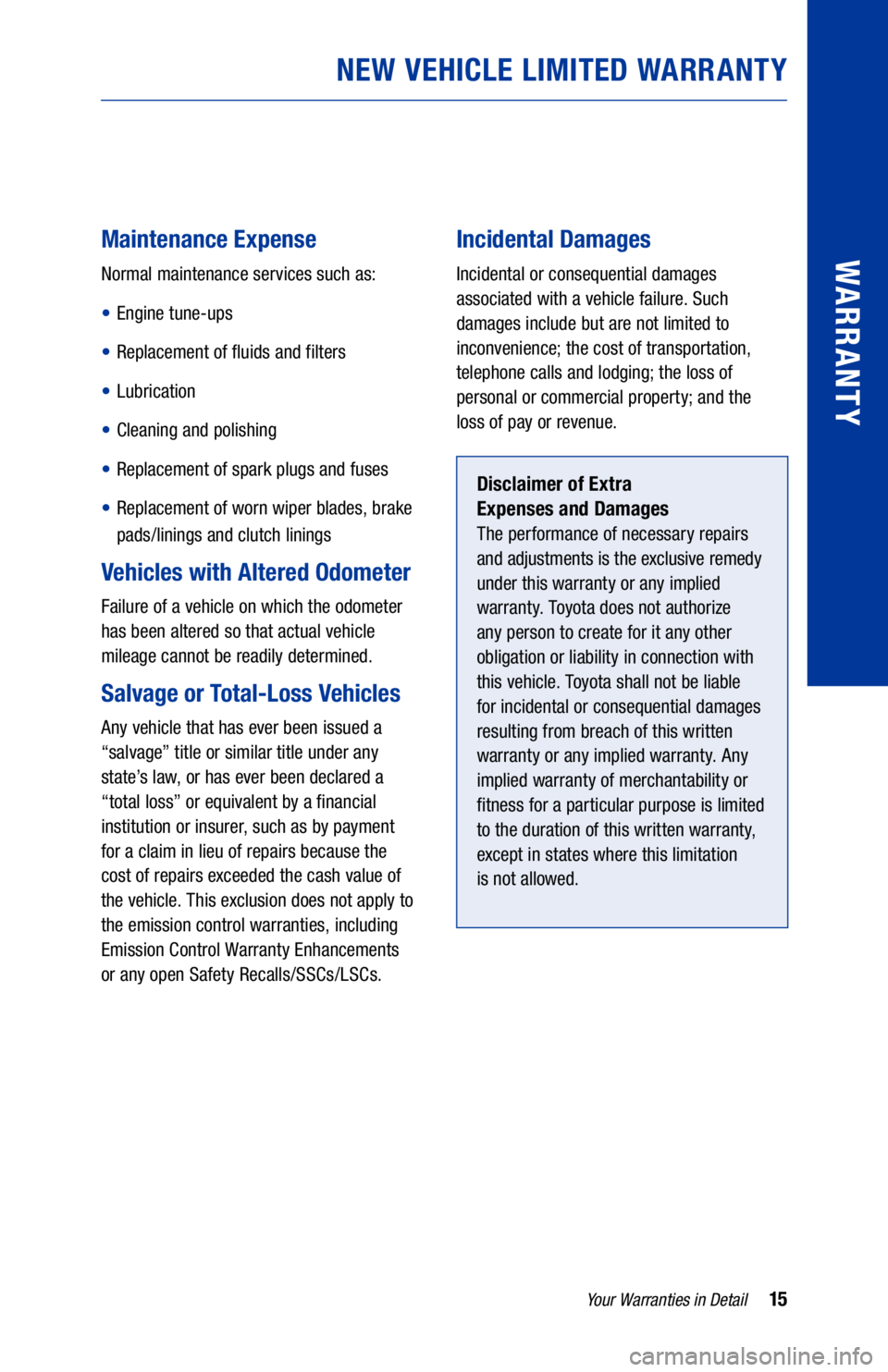
Maintenance Expense
Normal maintenance services such as:
• Engine tune-ups
• Replacement of fluids and filters
• Lubrication
• Cleaning and polishing
• Replacement of spark plugs and fuses
• Replacement of worn wiper blades, brake
pads/linings and clutch linings
Vehicles with Altered Odometer
Failure of a vehicle on which the odometer
has been altered so that actual vehicle
mileage cannot be readily determined.
Salvage or Total-Loss Vehicles
Any vehicle that has ever been issued a
“salvage” title or similar title under any
state’s law, or has ever been declared a
“total loss” or equivalent by a financial
institution or insurer, such as by payment
for a claim in lieu of repairs because the
cost of repairs exceeded the cash value of
the vehicle. This exclusion does not apply to
the emission control warranties, including
Emission Control Warranty Enhancements
or any open Safety Recalls/SSCs/LSCs.
Incidental Damages
Incidental or consequential damages
associated with a vehicle failure. Such
damages include but are not limited to
inconvenience; the cost of transportation,
telephone calls and lodging; the loss of
personal or commercial property; and the
loss of pay or revenue.
Disclaimer of Extra
Expenses and Damages
The performance of necessary repairs
and adjustments is the exclusive remedy
under this warranty or any implied
warranty. Toyota does not authorize
any person to create for it any other
obligation or liability in connection with
this vehicle. Toyota shall not be liable
for incidental or consequential damages
resulting from breach of this written
warranty or any implied warranty. Any
implied warranty of merchantability or
fitness for a particular purpose is limited
to the duration of this written warranty,
except in states where this limitation
is not allowed.
15
NEW VEHICLE LIMITED WARRANTY
Your Warranties in Detail
WARRANTY
Page 19 of 58
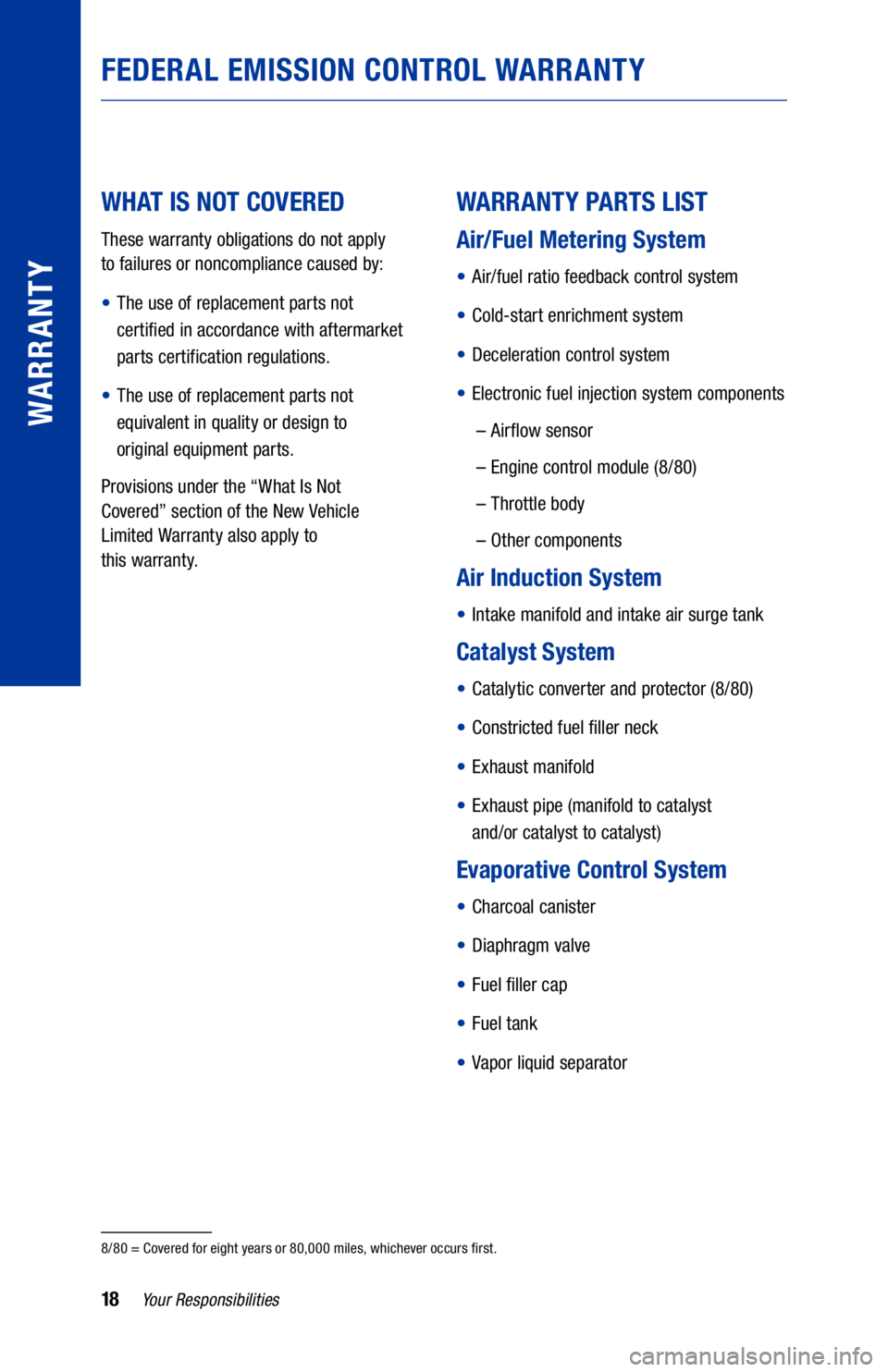
WHAT IS NOT COVERED
These warranty obligations do not apply
to failures or noncompliance caused by:
• The use of replacement parts not
certified in accordance with aftermarket
parts certification regulations.
• The use of replacement parts not
equivalent in quality or design to
original equipment parts.
Provisions under the “What Is Not
Covered” section of the New Vehicle
Limited Warranty also apply to
this warranty.
WARRANTY PARTS LIST
Air/Fuel Metering System
• Air/fuel ratio feedback control system
• Cold-start enrichment system
• Deceleration control system
• Electronic fuel injection system components
– Airflow sensor
– Engine control module (8/80)
– Throttle body
– Other components
Air Induction System
• Intake manifold and intake air surge tank
Catalyst System
• Catalytic converter and protector (8/80)
• Constricted fuel filler neck
• Exhaust manifold
• Exhaust pipe (manifold to catalyst
and/or catalyst to catalyst)
Evaporative Control System
• Charcoal canister
• Diaphragm valve
• Fuel filler cap
• Fuel tank
• Vapor liquid separator
8/80 = Covered for eight years or 80,000 miles, whichever occurs first.
18
FEDERAL EMISSION CONTROL WARRANTY
Your Responsibilities
WARRANTY
Page 24 of 58
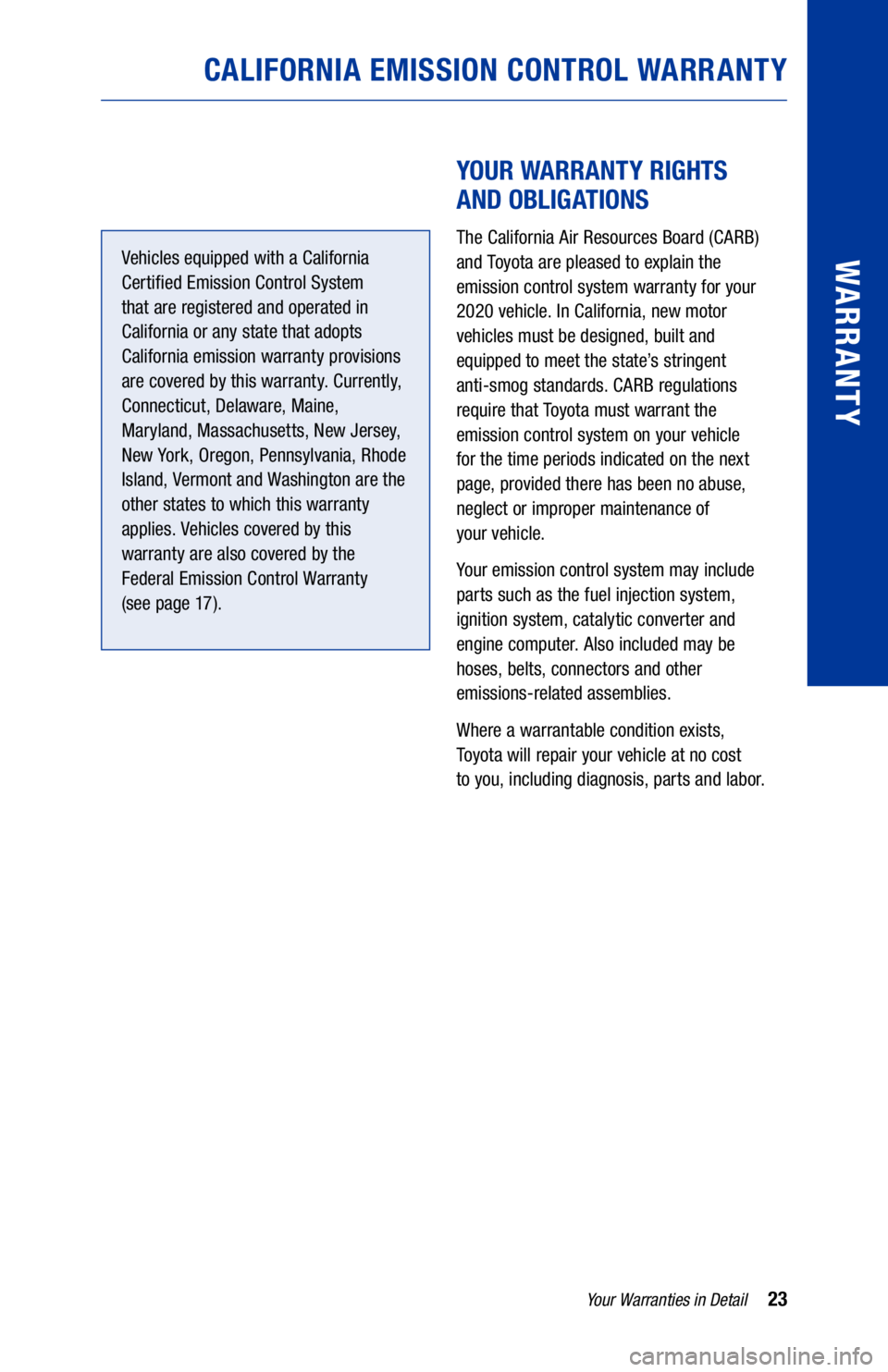
Vehicles equipped with a California
Certified Emission Control System
that are registered and operated in
California or any state that adopts
California emission warranty provisions
are covered by this warranty. Currently,
Connecticut, Delaware, Maine,
Maryland, Massachusetts, New Jersey,
New York, Oregon, Pennsylvania, Rhode
Island, Vermont and Washington are the
other states to which this warranty
applies. Vehicles covered by this
warranty are also covered by the
Federal Emission Control Warranty
(see page 17).
YOUR WARRANTY RIGHTS
AND OBLIGATIONS
The California Air Resources Board (CARB)
and Toyota are pleased to explain the
emission control system warranty for your
2020 vehicle. In California, new motor
vehicles must be designed, built and
equipped to meet the state’s stringent
anti-smog standards. CARB regulations
require that Toyota must warrant the
emission control system on your vehicle
for the time periods indicated on the next
page, provided there has been no abuse,
neglect or improper maintenance of
your vehicle.
Your emission control system may include
parts such as the fuel injection system,
ignition system, catalytic converter and
engine computer. Also included may be
hoses, belts, connectors and other
emissions-related assemblies.
Where a warrantable condition exists,
Toyota will repair your vehicle at no cost
to you, including diagnosis, parts and labor.
23
CALIFORNIA EMISSION CONTROL WARRANTY
Your Warranties in Detail
WARRANTY
Page 26 of 58
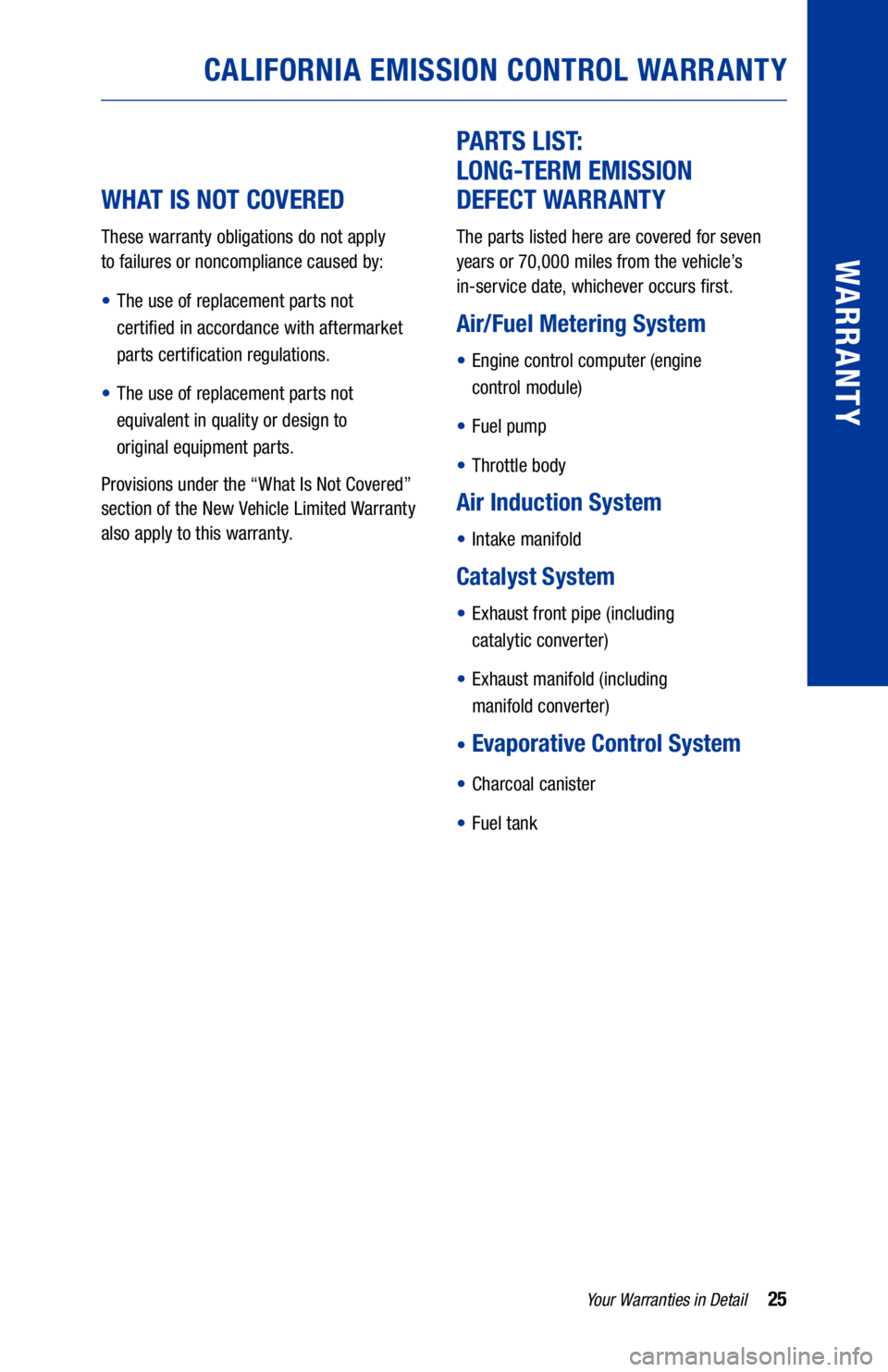
WHAT IS NOT COVERED
These warranty obligations do not apply
to failures or noncompliance caused by:
• The use of replacement parts not
certified in accordance with aftermarket
parts certification regulations.
• The use of replacement parts not
equivalent in quality or design to
original equipment parts.
Provisions under the “What Is Not Covered”
section of the New Vehicle Limited Warranty
also apply to this warranty.
PARTS LIST:
LONG-TERM EMISSION
DEFECT WARRANTY
The parts listed here are covered for seven
years or 70,000 miles from the vehicle’s
in-service date, whichever occurs first.
Air/Fuel Metering System
• Engine control computer (engine
control module)
• Fuel pump
• Throttle body
Air Induction System
• Intake manifold
Catalyst System
• Exhaust front pipe (including
catalytic converter)
• Exhaust manifold (including
manifold converter)
•
Evaporative Control System
• Charcoal canister
• Fuel tank
25
CALIFORNIA EMISSION CONTROL WARRANTY
Your Warranties in Detail
WARRANTY
Page 36 of 58
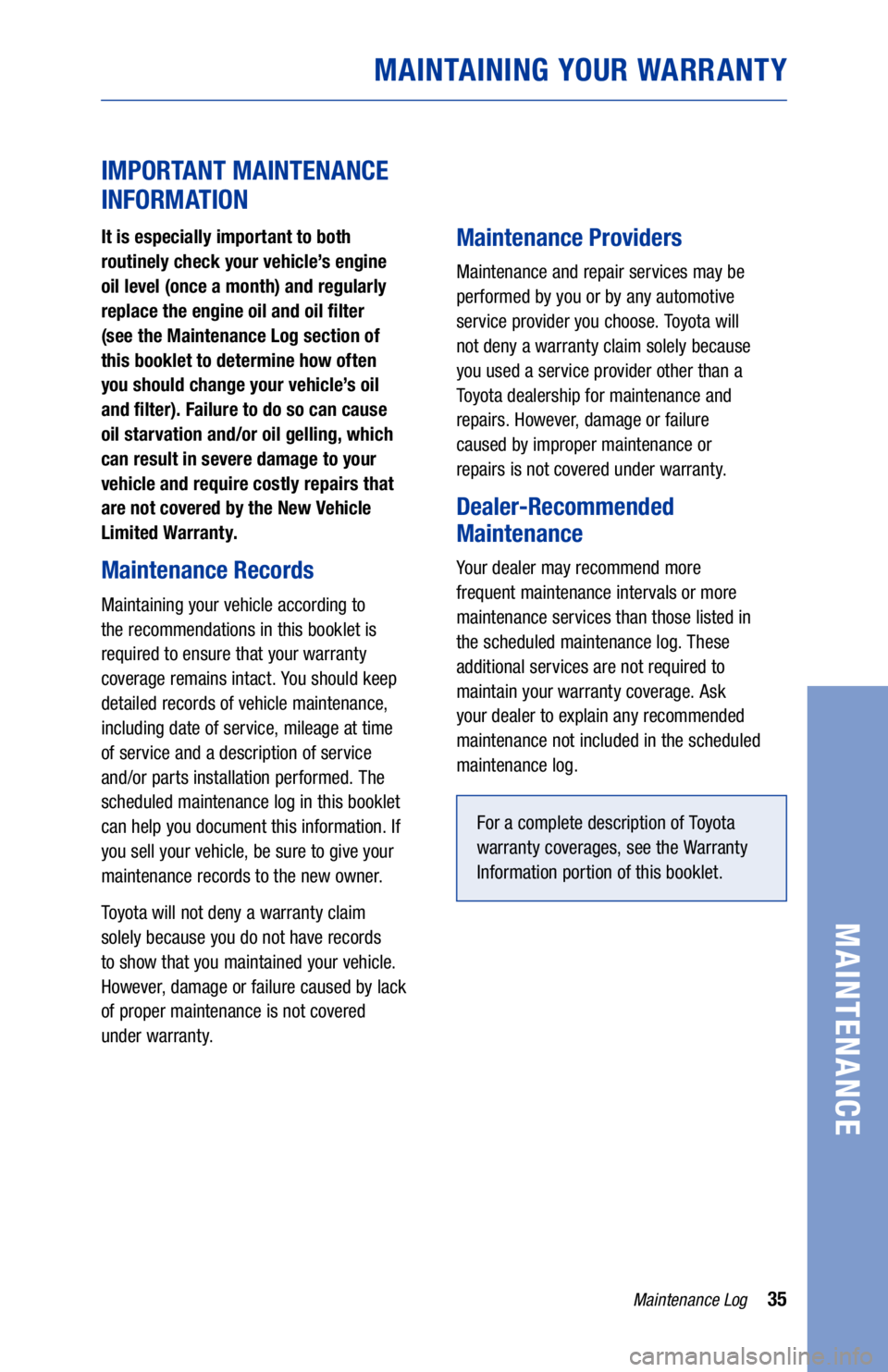
IMPORTANT MAINTENANCE
INFORMATION
It is especially important to both
routinely check your vehicle’s engine
oil level (once a month) and regularly
replace the engine oil and oil filter
(see the Maintenance Log section of
this booklet to determine how often
you should change your vehicle’s oil
and filter). Failure to do so can cause
oil starvation and/or oil gelling, which
can result in severe damage to your
vehicle and require costly repairs that
are not covered by the New Vehicle
Limited Warranty.
Maintenance Records
Maintaining your vehicle according to
the recommendations in this booklet is
required to ensure that your warranty
coverage remains intact. You should keep
detailed records of vehicle maintenance,
including date of service, mileage at time
of service and a description of service
and/or parts installation performed. The
scheduled maintenance log in this booklet
can help you document this information. If
you sell your vehicle, be sure to give your
maintenance records to the new owner.
Toyota will not deny a warranty claim
solely because you do not have records
to show that you maintained your vehicle.
However, damage or failure caused by lack
of proper maintenance is not covered
under warranty.
Maintenance Providers
Maintenance and repair services may be
performed by you or by any automotive
service provider you choose. Toyota will
not deny a warranty claim solely because
you used a service provider other than a
Toyota dealership for maintenance and
repairs. However, damage or failure
caused by improper maintenance or
repairs is not covered under warranty.
Dealer-Recommended
Maintenance
Your dealer may recommend more
frequent maintenance intervals or more
maintenance services than those listed in
the scheduled maintenance log. These
additional services are not required to
maintain your warranty coverage. Ask
your dealer to explain any recommended
maintenance not included in the scheduled
maintenance log.
For a complete description of Toyota
warranty coverages, see the Warranty
Information portion of this booklet.
35
MAINTAINING YOUR WARRANTY
Maintenance Log
MAINTENANCE
Page 38 of 58

Engine Oil and Filter
Maintenance
Your vehicle is equipped with 0W-20
synthetic oil, which allows for extended oil
change intervals and optimum fuel economy.
It is recommended that Toyota Genuine
0W-20 Motor Oil be used during scheduled
oil changes. For normal operating conditions,
Toyota recommends changing your oil
and filter every 7,500 miles or six months,
whichever occurs first. However, if your
vehicle is primarily driven under any of the
following Special Operating Conditions, it
is recommended that you change your oil
and filter every 5,000 miles or four months,
whichever occurs first:
• Driving on dirt roads or dusty roads
• Driving while towing, using a car-top carrier,
or heavy vehicle loading
• Repeated trips of less than five miles in
temperatures below 32°F /0°C
• Extensive idling and/or low speed driving
for a long distance, such as police, taxi or
door-to-door delivery use
Additional Maintenance
In addition to scheduled maintenance,
your Toyota requires ongoing general
maintenance, such as fluid checks and
visual inspections. These procedures are
explained in the “Maintenance and Care”
section of the Owner’s Manual. Be sure
to perform these procedures regularly to
ensure the most trouble-free operation
of your vehicle.
SuperChrome and
Alloy Wheel Care
If you purchased genuine Toyota accessory
SuperChrome or Aluminum Alloy Wheels,
follow these cleaning guidelines to maintain
the appearance of your wheels:
•
If wheels are hot, wait for them to cool
before washing.
•
Use a soft sponge or cotton cloth to
apply the same mild car-wash soap as
used for the vehicle body. Quickly rinse
off with water. Use a soft cloth to apply
the same car wax as used for the
vehicle body.
•
DO NOT USE: Any kind of chemical-
based cleaners, alcohol, solvents,
gasoline, steam cleaners, scouring
pads, wire brushes or coarse abrasives
to clean your wheels.
37
USING THE MAINTENANCE LOG CHARTS
Maintenance Log
MAINTENANCE
Page 39 of 58
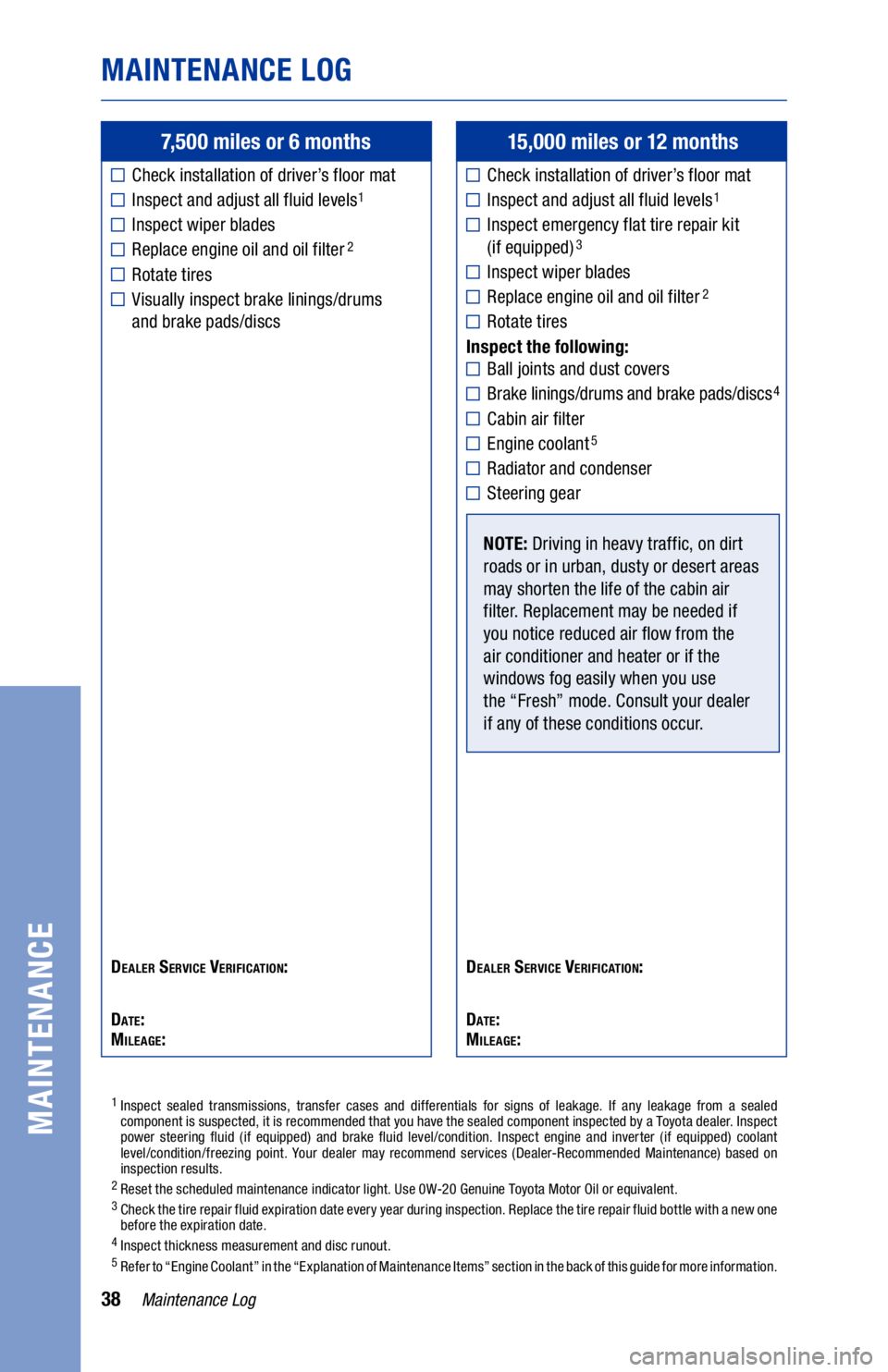
38
7,500 miles or 6 months
Check installation of driver’s floor mat
Inspect and adjust all fluid levels1
Inspect wiper blades
Replace engine oil and oil filter2
Rotate tires
Visually inspect brake linings/drums
and brake pads/discs
Dealer Service verification:
D
ate:
Mileage:
15,000 miles or 12 months
Check installation of driver’s floor mat
Inspect and adjust all fluid levels1
Inspect emergency flat tire repair kit
(if equipped)3
Inspect wiper blades
Replace engine oil and oil filter2
Rotate tires
Inspect the following:
Ball joints and dust covers
Brake linings/drums and brake pads/discs4
Cabin air filter
Engine coolant5
Radiator and condenser
Steering gear
NOTE: Driving in heavy traffic, on dirt
roads or in urban, dusty or desert areas
may shorten the life of the cabin air
filter. Replacement may be needed if
you notice reduced air flow from the
air conditioner and heater or if the
windows fog easily when you use
the “Fresh” mode. Consult your dealer
if any of these conditions occur.
Dealer Service verification:
D
ate:
Mileage:
1 inspect sealed transmissions, transfer cases and differentials for signs of leakage. if any leakage from a sealed
component is suspected, it is recommended that you have the sealed component inspected by a toyota dealer. inspect
power steering fluid (if equipped) and brake fluid level/condition. inspect engine and inverter (if equipped) coolant
level/condition/freezing point. Your dealer may recommend services (Dealer-recommended Maintenance) based on
inspection results.
2 reset the scheduled maintenance indicator light. Use 0W-20 genuine toyota Motor oil or equivalent.3 check the tire repair fluid expiration date every year during inspection. replace the tire repair fluid bottle with a new one
before the expiration date.
4 inspect thickness measurement and disc runout.5 refer to